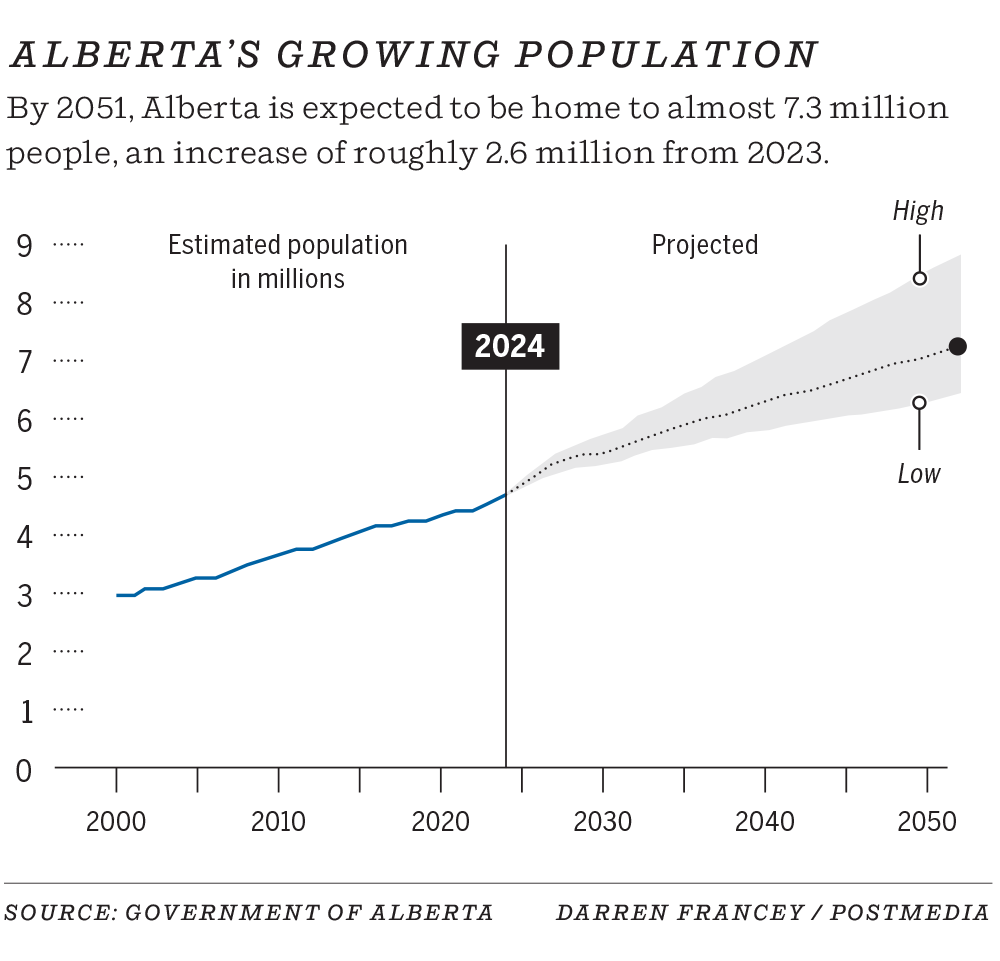The new growth projections released Tuesday also predict the province’s population will reach about 7.3 million by mid-century

Alberta’s population is expected to grow by 2.6 million people over the next 27 years — making the province older and more diverse, says a new government report.
The province is meanwhile riding a year-long streak in which it has absorbed the highest number of newcomers from other Canadian provinces, new Statistics Canada data show.
Alberta’s population grew by a Canada-leading 4.4 per cent between July 1, 2023, and July 1, 2024, a total increase of about 204,000 people — well above the national average (three per cent) and second-highest Ontario (3.2 per cent), according to Statistics Canada. The previous year, Alberta grew by more than 173,500 people. (Alberta’s population grew by one per cent in the second quarter, adding more than 46,000 people.)
“We’ve been very surprised by the resiliency of these population numbers in Alberta,” ATB economist Mark Parsons said. “They seem to be getting stronger.”
Alberta’s population is also poised to be several years older by 2051.
The average age in Alberta is expected to go from 39.1 years to 42.5 years over that time, which will create new pressures for health-care funding and result in slower economic growth, said Trevor Tombe, economist at the University of Calgary.
But Alberta will remain relatively young compared to the rest of Canada, he said. Canada’s average age is currently 40.3 years old and will likely also increase over the same period.
“That’s important perspective — we’ll still be a relatively young province, even though we’ll be, on average, older than we are now,” Tombe said.
Premier once mused about population reaching 10 million
Alberta added 18,050 people aged 16 to 19 alone over that year period.
“It’s just a huge pressure on the school system,” Tombe said.
“We take the view as a government that we just want to keep up with the growth. I love the fact that people want to live in Alberta and be part of everything that we have here,” Smith said at the time. Earlier in the year she had mused about the province reaching a population of 10 million by 2050 and Red Deer, a town of 103,000 people, eventually reaching the one-million mark.
“Our challenge of managing growth is so much easier than the alternative . . . this is a very fun challenge to have and we want to keep that going.”
Last week, Smith maintained the province’s increasing population is contributing to strong economic outcomes, but said Prime Minister Justin Trudeau’s immigration policy had broken the “delicate balance” and led to fewer job opportunities for young people, exacerbated the housing shortage and strained social services such as health care and education.
ATB foresees Alberta’s annual population growth slightly moderating in the next two to three years, reaching about three per cent annually and getting closer to two per cent in the years beyond, Parsons said.
While the federal government is imposing stronger limits on migration over the coming year, such as limits on temporary foreign workers, Parsons said Alberta will likely be less affected by those measures than provinces such as Ontario. (Alberta’s allocation for international students, for example, is expected to increase, while Ontario’s will be cut by as much as half.)
Overall, Parsons said the latest wave of migration has primarily been driven by Alberta’s relative affordability compared to other areas of Canada.
“It’s very normal for Alberta to be a net recipient migrants from other provinces,” he said. “But what makes this migration cycle unique is that it’s not being driven by the same oil and gas boom that you would normally have when you see numbers this strong.”
